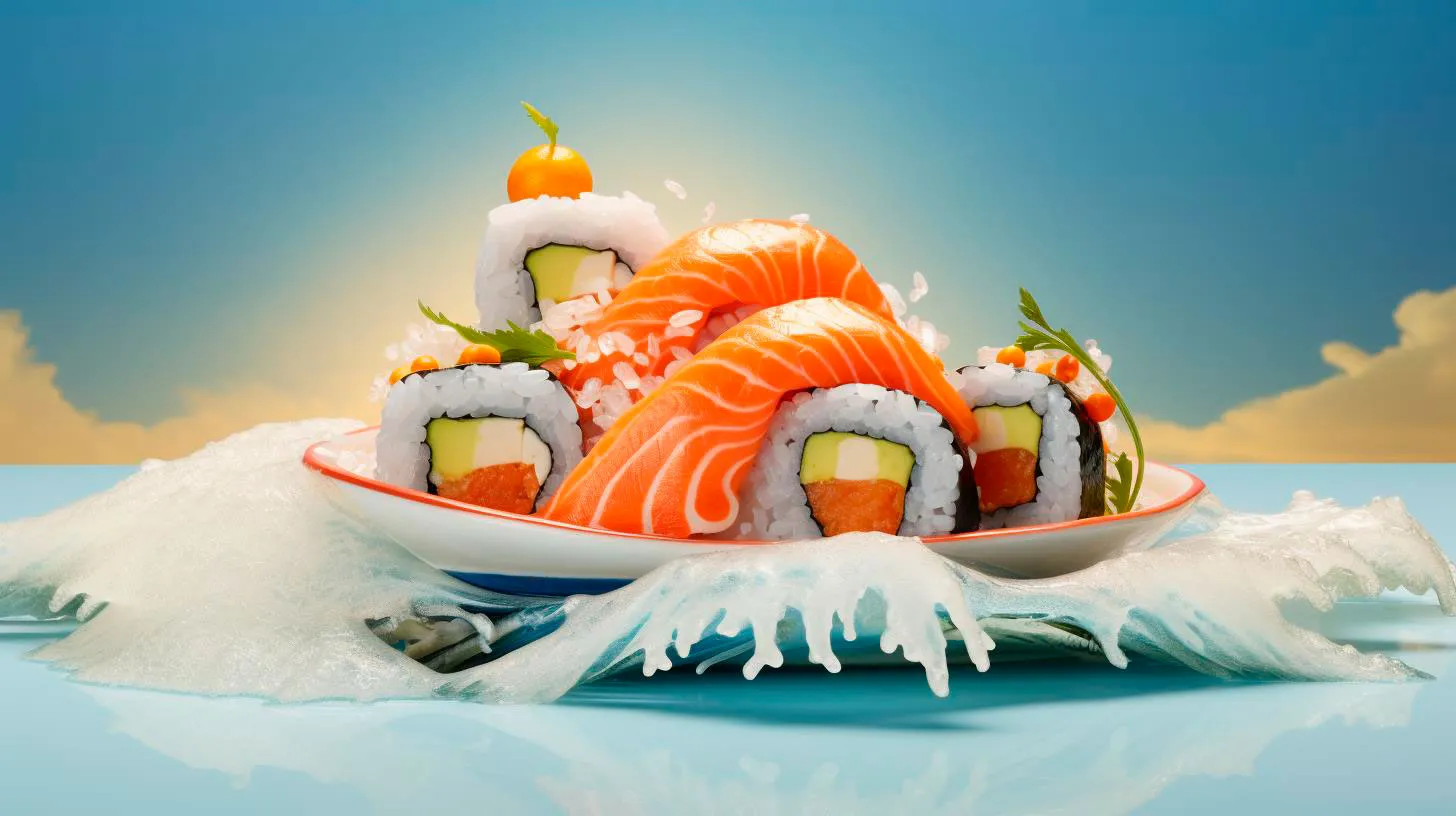Savoring the Details: Ingredients in Japanese Sushi
From the freshest fish to the artful inclusion of vegetables and seasonings, every element plays a crucial role in creating the perfect sushi experience. In this article, we delve into the key ingredients that make up this beloved dish and explore their significance.
The Rice: The Foundation of Sushi
At the heart of every piece of sushi lies a bed of perfectly seasoned sushi rice. This short-grain rice, known as shari, is essentially a canvas for the other ingredients. The rice is first washed and cooked to perfection, achieving a sticky yet firm texture. It is then mixed with a blend of vinegar, sugar, and salt, known as sushi-zu, to provide a delicate balance of flavors.
Key Takeaway: The perfect sushi rice forms the base for every sushi dish, allowing flavors to meld harmoniously and providing the characteristic texture sushi is known for.
Sashimi-Grade Fish: The Highlight of Sushi
When it comes to sushi, the quality of the fish is paramount. Sashimi-grade fish refers to the highest quality fish that is safe to be consumed raw. Common choices include tuna, salmon, and yellowtail, but the selection varies depending on availability and regional preferences. Fish selection is key, as it greatly influences the taste and texture of the final sushi dish.
- Quality sushi-grade fish is characterized by its vibrant color, firm texture, and fresh aroma.
- It is advisable to source fish from reputable suppliers to ensure it meets the necessary safety standards for raw consumption.
Vegetables: Adding Vibrance and Texture to Sushi
While fish takes the spotlight, vegetables play an essential supporting role in sushi. Commonly used vegetables include cucumber, avocado, and daikon radish. These ingredients bring a refreshing crunchiness and add a burst of color to the sushi rolls. They also provide a contrast of flavors that complements the richness of the fish.
Key Takeaway: The inclusion of vegetables in sushi not only enhances its visual appeal but also adds an element of freshness and balances the overall flavor profile.
Wasabi and Soy Sauce: The Perfect Partners
No sushi experience is complete without accompanying it with soy sauce and wasabi. Wasabi, a pungent green paste derived from the wasabi root, adds a unique spiciness to the sushi, awakening the senses with its distinct flavor. Soy sauce, on the other hand, provides a savory and slightly salty taste that enhances the overall umami experience. It is essential to dip sushi lightly into the soy sauce to avoid overpowering the delicate balance of flavors.
- Wasabi is known for its antimicrobial properties, which help prevent foodborne illnesses.
- Soy sauce contains high levels of antioxidants and may offer health benefits when consumed in moderation.
Seaweed: The Wrapper That Holds It All
Nori, a type of edible seaweed, is used to wrap sushi rolls and nigiri. This thin, dark sheet adds a slightly salty and earthy taste to enhance the overall flavor profile. It provides structural integrity to sushi rolls, ensuring that all the ingredients stay intact and adding a satisfying texture with every bite.
Key Takeaway: Nori serves not only as an edible wrapper but also as a flavor enhancer and textural component of sushi.
Conclusion
Sushi is a delightful culinary journey, where each ingredient plays a vital role in creating a harmonious symphony of flavors. From the perfectly seasoned sushi rice to the freshest fish, vegetables, and condiments, each component contributes to the overall gastronomic experience. Understanding and savoring the intricate details of sushi ingredients will enhance your appreciation of this iconic Japanese dish, making every bite a truly memorable one.
From Maki to California Roll: America’s Sushi Evolution
Join us as we explore the fascinating history and evolution of sushi in America.
The Introduction of Sushi to America
The story of sushi in America dates back to the late 19th century when Japanese immigrants first arrived on the West Coast. Bringing their culinary traditions with them, sushi started gaining popularity among Japanese communities in places like San Francisco and Los Angeles. Back then, sushi was predominantly enjoyed in traditional Japanese sushi bars, where chefs would create artful plates of nigiri, sashimi, and maki rolls.
However, it wasn’t until the 1960s and 1970s that sushi began to gain mainstream attention. As international trade and travel increased, Americans were introduced to Japanese cuisine, and sushi started appearing on menus in upscale restaurants. This marked the beginning of sushi’s evolution in America as it started adapting to local preferences and incorporating new flavors.
The Birth of the California Roll
One significant turning point in America’s sushi evolution was the creation of the California Roll. In the 1960s, a sushi chef named Ichiro Mashita in Los Angeles came up with a genius idea of using avocado instead of expensive toro (fatty tuna) and adding crab meat and cucumber. This innovation made sushi more approachable to Americans who were still getting used to the idea of raw fish.
The California Roll gained popularity rapidly and opened doors for further experimentation. Instead of traditional nori (seaweed), the roll was often wrapped in sesame seeds or rice paper to suit local tastes. This fusion creation became a gateway for many Americans to explore the world of sushi, leading to the introduction of countless creative rolls over the years.
The Rise of Fusion and Specialty Rolls
As sushi became more mainstream, American chefs began introducing their own twists and flavors to traditional Japanese sushi. Fusion rolls combining different cuisines and flavors started appearing on menus across the country. Sushi rolls with ingredients like cream cheese, spicy mayo, and even fried chicken became the norm.
Specialty rolls also gained immense popularity among sushi enthusiasts. These rolls were known for their unique combinations of flavors, textures, and artistic presentations. Some popular specialty rolls include the Spider Roll (featuring deep-fried soft-shell crab) and the Dragon Roll (with eel and avocado topping).
Sushi Trends and Modern Innovations
The sushi evolution in America hasn’t stopped yet. Today, sushi has become a global phenomenon, and trends continue to emerge, showcasing new and exciting flavors. The use of sustainable seafood has been one of the significant shifts in recent years, as conscious consumers demand ethical choices.
Another modern innovation is the rise of conveyor belt sushi, also known as kaiten-zushi. This popular trend allows diners to grab their favorite sushi directly from a rotating conveyor belt, making the experience fast, fun, and interactive.
Key Takeaways:
- Sushi was introduced to America by Japanese immigrants in the late 19th century.
- The creation of the California Roll made sushi more accessible to Americans.
- American chefs started fusion and specialty rolls with their own unique ingredients and flavors.
- Sustainable seafood and conveyor belt sushi are recent trends in the evolution of sushi in America.
The evolution of sushi in America has been an exciting journey from traditional nigiri to fusion rolls and specialty creations. The introduction of sushi to the Western world paved the way for culinary innovation, adapting to local tastes and preferences. As sushi continues to evolve, one thing is certain – it has become a beloved cuisine loved by people from all walks of life.
Battle of the Rolls: The Authenticity Debate
The Rise of Sushi Rolls
Sushi, originating in Japan, has surely made its mark on the international culinary scene. Traditionally, sushi rolls, or makizushi, are made with seaweed, rice, and a combination of raw fish, vegetables, or other fillings. This traditional approach has captured the hearts (and taste buds) of sushi purists around the globe.
However, as sushi became more popular outside of Japan, it naturally underwent various adaptations and transformations to cater to different palates. Chefs experimented, combining flavors and experimenting with new ingredients to create fusion sushi rolls – the kind that differs from the authentic, traditional versions. These fusion rolls were influenced by other cuisines, such as American or Mexican, resulting in combinations like the California roll or the spicy tuna roll, which quickly became crowd favorites.
The Authenticity Dilemma
So, here’s the burning question: which is better, the traditional authentic rolls or the more contemporary, fusion versions?
Advocates of traditional sushi rolls argue that preserving authenticity is crucial to fully appreciate the flavors and cultural significance of this Japanese delicacy. They believe that by straying from tradition, we risk diluting the essence of sushi. Authentic rolls adhere to time-tested techniques and offer a true taste of Japan.
On the other hand, proponents of fusion sushi rolls argue that culinary innovation is an essential element of any cuisine’s evolution. Fusion sushi rolls allow for creativity and experimentation, catering to the diverse palates of the modern world. They argue that fusion rolls bring excitement to the dining experience by incorporating unexpected ingredients, textures, and flavors.
The Battle of the Rolls: Features and Advantages
To help you navigate the authenticity debate, let’s take a closer look at the features, advantages, and key takeaways of each roll style:
Traditional Rolls:
- Preserves the essence of Japanese culinary traditions.
- Focuses on simplicity and purity of flavors.
- Offers a genuine experience for sushi purists seeking a taste of Japan.
- Exquisite craftsmanship in rolling and presentation.
- Uses high-quality ingredients to create a refined taste.
- Packaged with cultural and historical significance.
Fusion Rolls:
- Infuses unexpected flavor combinations and ingredients.
- Brings excitement and novelty to the dining experience.
- Appeals to adventurous eaters who enjoy experimenting.
- Reflects the dynamic nature of culinary evolution.
- Caters to a wider range of tastes and preferences.
- Combines influences from various cuisines, resulting in a unique fusion of flavors.
Key Takeaways
Ultimately, the battle of the rolls boils down to personal preference. Whether you lean towards the traditional or favor the fusion approach, both styles offer something unique and enjoyable. It’s an opportunity to explore the rich culinary heritage of Japan or embark on a flavor adventure that combines various culinary traditions.
Regardless of your choice, the popularity of both traditional and fusion sushi rolls continues to grow. Thanks to these adaptations, sushi has become widely accessible, bridging cultural gaps and expanding global palates. So, the next time you find yourself in a sushi restaurant, embrace the debate and indulge in whichever roll style resonates with you.
Sushi Showdown: Traditional vs Fusion
Traditional Sushi: A Taste of Authenticity
Traditional sushi, also known as Edomae sushi, can be traced back to the 19th century in the Edo period in Japan. It focuses on simplicity, showcasing the natural flavors of the ingredients used. Traditional sushi typically includes the following:
- Nigiri: Authentic sushi consisting of a topping (usually raw fish) served over seasoned sushi rice.
- Sashimi: Fresh slices of raw fish or other seafood, served without rice.
- Maki: Rolled sushi with seaweed wrapped around the filling and rice.
Key features of traditional sushi include:
- Minimalism in both presentation and ingredients.
- High-quality and premium-grade ingredients that are locally sourced.
- Emphasis on the natural flavors of fish or seafood.
- Simple soy sauce and wasabi accompaniments.
The advantages of traditional sushi are:
- Preserving the rich cultural heritage and authenticity of Japanese cuisine.
- Highlighting the freshness and delicate flavors of the fish or seafood.
- A more authentic and traditional experience for sushi enthusiasts.
Fusion Sushi: A Modern Twist
Fusion sushi is a contemporary variation that brings together Japanese flavors with a mix of international culinary influences. The fusion concept has gained popularity due to its unique and innovative combinations. Some examples of fusion sushi variations include:
- California Roll: Filled with avocado, crab meat, and cucumber, and often coated with sesame seeds or tobiko (flying fish roe).
- Spicy Tuna Roll: A combination of tuna and spicy mayo, providing a kick of flavor.
- Tempura Roll: A deep-fried roll typically filled with tempura shrimp, avocado, and cucumber.
Key features of fusion sushi include:
- Experimentation with ingredients and flavors from different cuisines.
- Creative presentation and unique combinations.
- Playful use of sauces, spices, and other condiments.
- Incorporation of non-traditional ingredients such as cream cheese or mango.
The advantages of fusion sushi are:
- Introducing new flavors and textures to sushi enthusiasts.
- Appealing to a wider audience with diverse taste preferences.
- Providing a modern and unconventional twist to the traditional sushi experience.
Key Takeaways
Choosing between traditional and fusion sushi ultimately depends on personal preference. Some individuals may prefer the simplicity and authenticity offered by traditional sushi, appreciating the focus on the natural flavors of the fish or seafood. On the other hand, fusion sushi offers a more adventurous eating experience, blending different cuisines and allowing for experimentation.
Ultimately, the beauty of sushi lies in its ability to cater to various palates and preferences. Regardless of whether you opt for traditional or fusion sushi, one thing remains consistent: the artistry and skill needed to create each roll. So next time you’re at a sushi restaurant, choose the style that intrigues you the most, sit back, and enjoy a culinary journey like no other!


